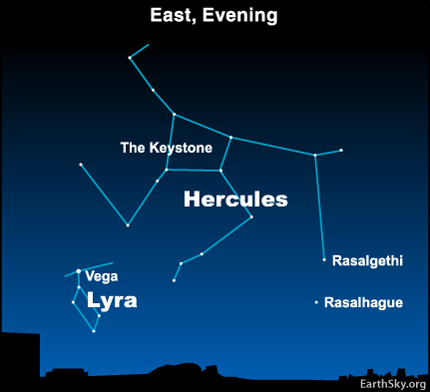 Courtesy of EarthSky
Courtesy of EarthSky
A Clear Voice for Science
www.EarthSky.org
 Hercules the Hero is not the easiest constellation to identify. You will need a dark sky to see this mighty star figure. However, if you can see Vega – a prominent blue-white star in the northeast in the evening now – you might spot Hercules nearby.
Hercules the Hero is not the easiest constellation to identify. You will need a dark sky to see this mighty star figure. However, if you can see Vega – a prominent blue-white star in the northeast in the evening now – you might spot Hercules nearby.
Still can’t see it? Look back at this chart to see Hercules with respect to both Vega and another star, Arcturus.
The most noticeable part of Hercules is an “asterism” or noticeable pattern of stars – in this case a lopsided square – in the center of this constellation. This asterism within Hercules is called The Keystone. It is all most people ever see of this large constellation.
However, Hercules extends beyond its central Keystone. This constellation is in fact quite large and in ancient times was sometimes called the Kneeling Giant. Hercules also appeared in the skylore of western skywatchers in the Middle East, where it represented Gilgamesh, an epic hero of Sumerian and Babylonian mythology.
The brightest star in Hercules is not in the Keystone; it is Ras Algethi, which is known to people with telescopes as a double star with a pretty color contrast, one red and one blue. Just don’t confuse Ras Algethi with nearby Rasalhague, which is the brightest star in the constellation Ophiuchus the Serpent Bearer. Rasalhague is white, while Ras Algethi appears red.
Written by admin
Astronomy Picture of the Day from NASA/JPL
U.S. Naval Observator Astronomical Information center
The York County Astronomical Society
 Print This Post
Print This Post








